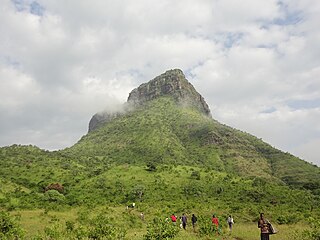
Mbale District is a district in Eastern Uganda. It is named after the largest city in the district, Mbale, which also serves as the main administrative and commercial center in the sub-region.

Kotido District is a district in Northern Uganda. It is named after its 'chief town', Kotido, where the district headquarters are located.

Moroto District is a district in the Northern Region of Uganda. The town of Moroto is the site of the district headquarters.

Kapchorwa District is a district in the Eastern Region of Uganda. The town of Kapchorwa is the district's main municipal, administrative, and commercial center, and is the site of the district headquarters. It is also the home district of Stephen Kiprotich, the men's marathon gold medalist at the 2012 Summer Olympics, and Joshua Cheptegei, the men's 5,000 m gold medalist at the 2021 Summer Olympics in Tokyo.

Mbale is a city in the Eastern Region of Uganda. It is the main municipal, administrative, and commercial center of Mbale District and the surrounding sub-region.

Moroto is a town in Moroto District in the Northern Region of Uganda. The town serves as the location of the district headquarters.

The Karamoja sub-region, commonly known as Karamoja, is a region in Uganda. It covers an area of 27,528km and comprises the Kotido District, Kaabong District, Karenga District, Nabilatuk District, Abim District, Moroto District, Napak District, Amudat District and Nakapiripirit District. The region is projected to have a population of 1.4 millions in 2022 by UBOS.

Nakapiripirit is a town in the Nakapiripirit District of the Northern Region of Uganda. It is the seat of the district headquarters. As an administrative unit of the district, it is one of the eight sub-counties in the district.

Amuria is a town in the Eastern Region of Uganda. It is the chief municipal, administrative, and commercial center of Amuria District, in the Teso sub-region.

Kumi Town, commonly called Kumi, is a town in the Eastern Region of Uganda. It is the main municipal, administrative, and commercial center in Kumi District and the site of the district headquarters.

Abim District is a district in Northern Uganda. It is named after its 'chief town', Abim, where the district headquarters are located.

Kaabong is a town in the Northern Region of Uganda. It is the chief municipal, administrative and commercial center of the eponymous Kaabong District, and the district headquarters are located in the town.

Moroto Regional Referral Hospital, commonly known as Moroto Hospital is a hospital in the town of Moroto, in Northeastern Uganda. It is the referral hospital for the districts of Abim, Kaabong, Kotido, Moroto and Nakapiripirit and Napak.

Bulambuli District is a district in Eastern Uganda. The district is named after 'chief town', Bulambuli, where the district headquarters are located.

Amudat District is a district in Northern Uganda. Like most Ugandan districts, it is named after its 'chief town', Amudat, where the district headquarters are located.

Napak District is a district in Northern Uganda. It is named after Mount Napak, and its headquarters is at Lokitede.
Moroto–Nakapiripirit Road is a road in the Northern Region of Uganda. The road connects the towns of Moroto, the largest town in the Karamoja sub-region, and Nakapiripirit in the same sub-region.
Muyembe–Nakapiripirit Road is a road in the Eastern and Northern regions of Uganda. The road connects the towns of Muyembe in Bulambuli District, to the town of Nakapiripirit in Nakapiripirit District.
Muyembe is a town in the Eastern Region of Uganda.
The Eastern Uganda campaign of 1979 was a military operation by Tanzanian forces and allied Ugandan rebels, most importantly the Uganda National Liberation Army, against Uganda Army (UA) troops loyal to Idi Amin during the Uganda–Tanzania War. The operation was launched by the Tanzania People's Defence Force (TPDF) on 15 April 1979 to secure eastern Uganda and oust UA remnants which were still active in the area. The TPDF mainly targeted the important towns of Jinja, Mbale, Tororo, Soroti, and Moroto. It encountered only sporadic resistance, as most UA soldiers focused on fleeing with loot instead of resisting, and successfully secured most of eastern Uganda. In the northeast, the collapse of the Uganda Army resulted in local Karamojong groups seizing much weaponry which would result in long-lasting security issues.


















